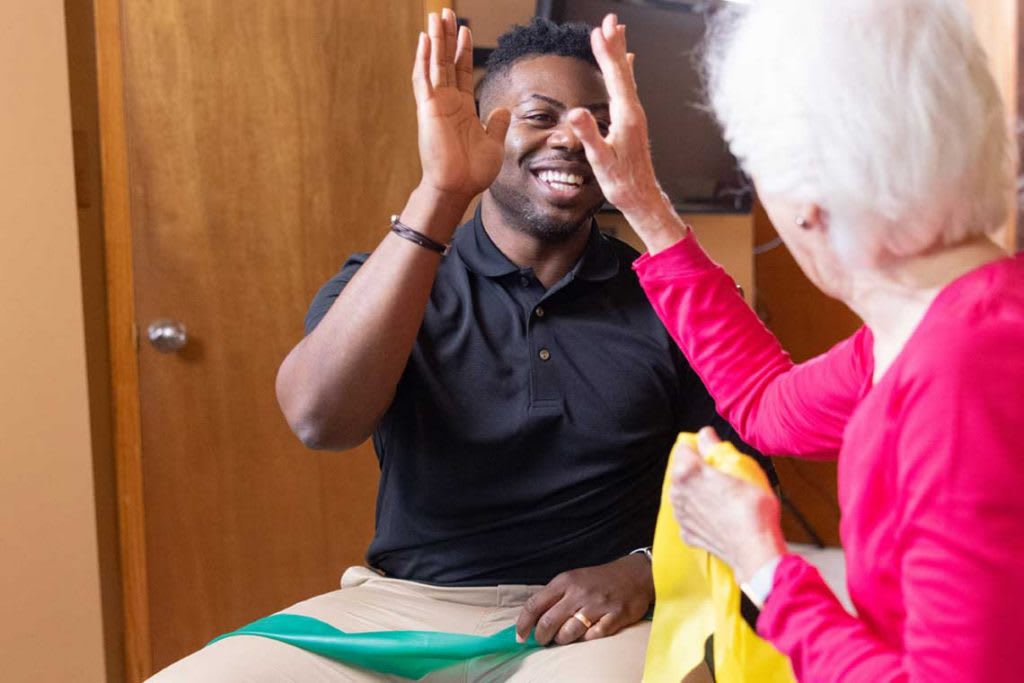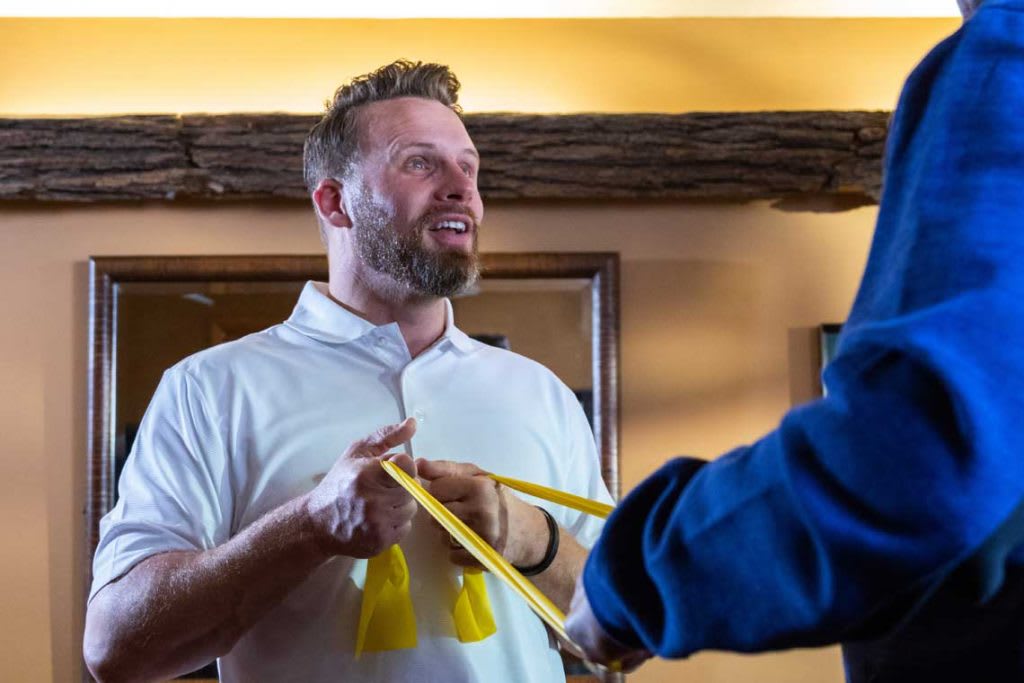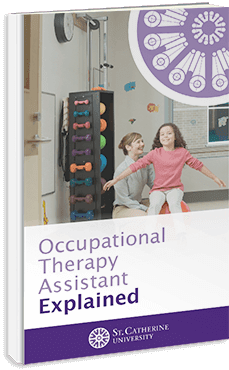What Does an Occupational Therapy Assistant Do?
Each blog post is dated and contains accurate information as of that date. Certain information may have changed since the blog post publication date. If you would like to confirm the current accuracy of blog information, please visit our Online OTA program overview page or contact us at (877) 223-2677.
What does an occupational therapy assistant do? An occupational therapy assistant job description can vary based on practice area. Some specialize in working with children or clients with chronic diseases. Generally, an OTA helps clients overcome physical and mental limitations to live more independently.

If you’re considering returning to school to pursue a healthcare career, you might consider becoming an occupational therapy assistant or OTA. What does an occupational therapy assistant do, exactly, and what does an occupational therapy assistant job description look like?
OTAs work with people of all ages with functional impairments, helping them develop, improve or recover skills needed for daily living. They work closely with their clients to identify their specific needs and goals and create a personalized plan to help them improve their skills.
It’s a rewarding career path where you can make a direct impact on the lives of others. It’s also a field where there are plenty of job opportunities. A career as an OTA offers flexibility, variety and creative problem-solving and is very meaningful as a profession. OTA was recently named the No. 1 Best Health Care Support Job by U.S. News and World Report.
This blog will discuss what you can expect in a typical occupational therapy assistant job description.

What does an occupational therapist do? Read all about a day in the life of an occupational therapist.
Occupational Therapy Assistants Give Personalized Care
So, what does an OTA do? Working alongside an occupational therapist, OTAs deliver treatment plans, document and review progress and work with the occupational therapist to make required adjustments to a patient’s care plan. Personalized care means a plan is created for each client based on their needs and goals.
The OTA then helps people do the activities outlined in their plan and tracks their progress to see if they are improving and to work towards the patient’s goals. The OTA may also recommend adaptive equipment to help clients build on their strengths and improve their abilities. They will adjust the plan to serve the client best, allowing them to continue progressing. Lastly, this job entails educating and training clients, families and caregivers.

Personalized care is vital because it meets each person’s needs based on what is meaningful to them. This helps them recover and improve their skills to enhance daily functioning. The OT and OTA work together to offer their clients:
- Guidance
- Instructions
- Education
- Support
Due to the many needs served by occupational therapy, you can find OTAs in many settings, including hospitals, rehab centers, schools, nursing homes, retirement communities and more.
One of the best things about being an OTA is that every day is different, bringing new challenges and opportunities to make a difference in clients’ lives.

Interested in learning more about the field? Find out why occupational therapy is important.
What Does an Occupational Therapy Assistant Do Each Day?
Each day might look a little different for an OTA, depending on which patients they’re working with on any given day. To get a better sense of what being an OTA can entail, imagine for a moment that you are a patient who has recently suffered a severe arm injury. You’re discovering that it significantly limits your day-to-day functioning.
Recovering from an arm injury could take weeks or even months. If you love cooking, you may want to return to the kitchen before that long. That’s where an OTA comes in. Simple tasks like holding a knife, dicing vegetables or sautéing meals may be more challenging for you now.
Fortunately, these are all things an OTA can teach you to do differently to accommodate your limitations — whether you’re wearing a cast, struggling with range of motion or battling arthritis.
Your OTA could show you alternative ways to hold the knife or introduce you to cooking utensils with adjustable handles. Your OTA would not focus purely on strengthening your arm but instead on helping you find ways to continue doing what you love.
An OTA career is rewarding because you can see the difference your work makes in every patient’s life.

What Does an OTA Do in Different Practice Areas?
Answering, “What does an occupational therapy assistant do?” can look slightly different, depending on which practice area is involved. OTAs can work within six distinct practice areas, as follows:
- Children and Youth: This practice area includes children and young adults with autism, learning challenges or physical limitations.
- Productive Aging: This well-known niche includes elderly clients who may need your help maintaining their independence within the home, adapting to using a wheelchair or learning new ways to cook and clean.
- Health and Wellness: Clients in this segment have chronic diseases or chronic pain and rely on occupational therapy to stay mobile, maintain healthy activity levels and continue healthy lives. These OTAs will also reach out to their communities to spread awareness regarding nutrition and overall health.
- Mental Health: OTAs work within a mental health environment to help these clients develop essential life skills and overcome mental health challenges.
- Rehabilitation and Disability: You would help clients suffering from injuries or illness to help them regain independence.
- Work and Industry: These clients need occupational therapy to return to work after an injury or illness. You might help them adapt to their work environment and tasks or find ways to help prevent injuries.

Thinking about transferring careers? Learn more about returning to school for a career change to occupational therapy.
What Types of Conditions Do OTAs Help Clients Adapt To?
Occupational therapy can transform clients’ lives by empowering them to overcome functional limitations and achieve greater independence. This can also positively affect their mental health, giving them the confidence they need to navigate life.
An OTA can work with diverse clients experiencing different types of limitations. Some examples of these conditions can include:
- Arthritis
- Acute injuries, such as fractures
- Stroke
- Carpal tunnel syndrome
- Parkinson’s disease
- Multiple sclerosis (MS)
- Autism spectrum disorder (ASD)
- Cerebral palsy
- Brain injury
- Amputations
Six Examples of OTA Treatment Activities

Because of the diverse nature of occupational therapy, occupational therapy assistants can work in various settings with clients of all ages. In each setting, OTAs create a personalized treatment plan for each client.
Here are six examples of treatment activities from different settings where OTAs can work:
- Assist a client with a spinal cord injury while transferring to a tub bench so they can become more independent while showering at home.
- Work with a client on home modifications for safety, including removing tripping hazards like loose rugs, installing grab bars in the bathroom and adding lighting to dark areas in the home.
- Help a child improve their handwriting skills through a handwriting curriculum and feedback on letter formation and spacing.
- Help a post-stroke client return to playing cards by using a cardholder to hold them while using their affected arm to pick up and play them.
- Use a picture schedule to provide visual support for a child, helping them stay organized at school and remain focused on classroom activities.
- Guide a client with depression and anxiety through relaxation techniques they can use to help manage their stress while shopping in a crowded grocery store.

OTAs are in high demand. Find out why the OTA career outlook is bright.
Earn Your OTA Degree from St. Kate’s in as Few as 16 Months
An occupational therapy assistant works to improve the quality of life for people in their community. This work can be precious for the clients and have lasting positive effects on the OTA. Changing someone’s life for the better through occupational therapy is a rewarding and achievable career path you could be on sooner than you may think.

Are you interested in finding out how you can pursue an exciting career as an occupational therapy assistant? With three start dates each year and spots available now, you can start working toward becoming an OTA in as few as 16 months at St. Kate’s.
Contact an admissions advisor today and take the first step toward your new career.


